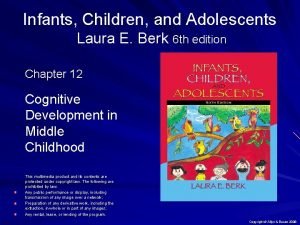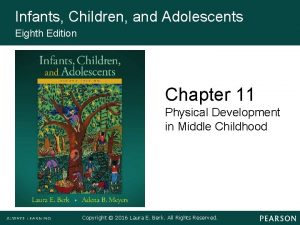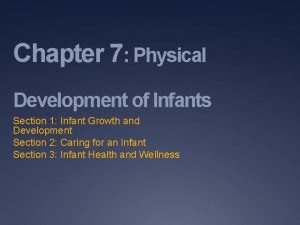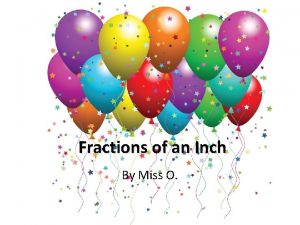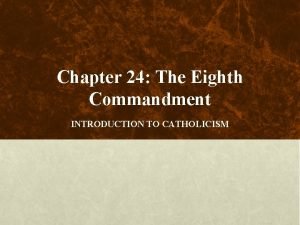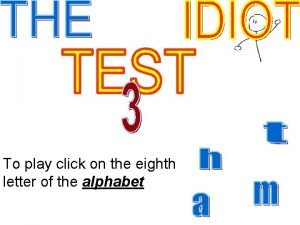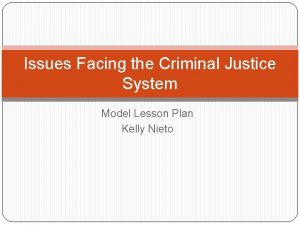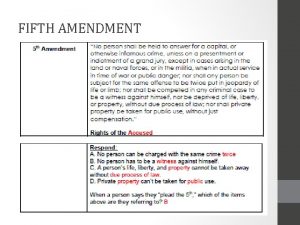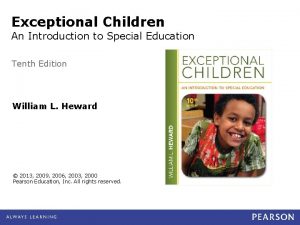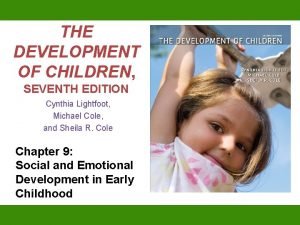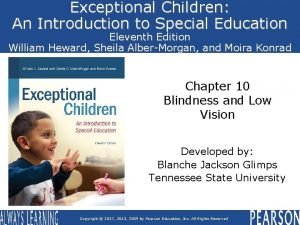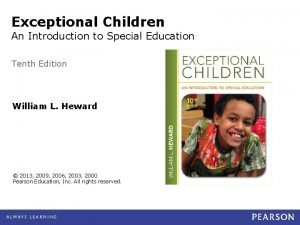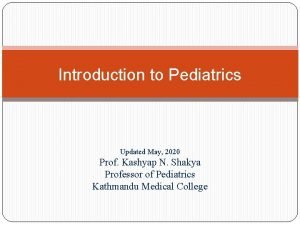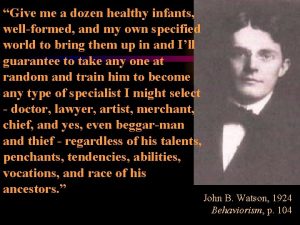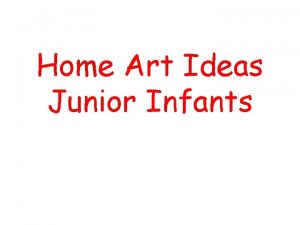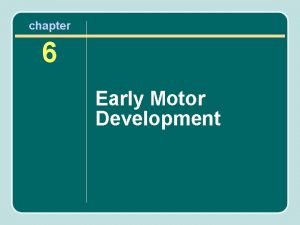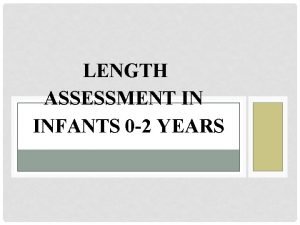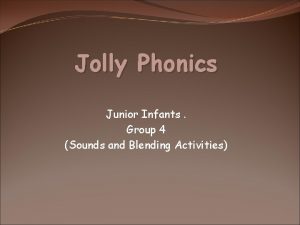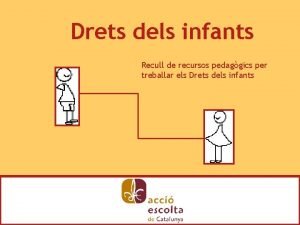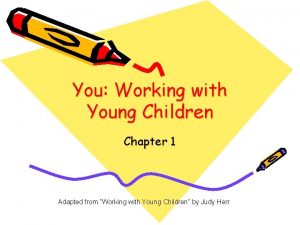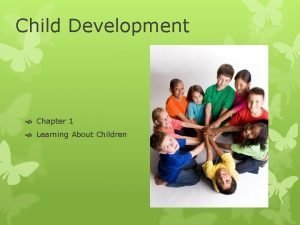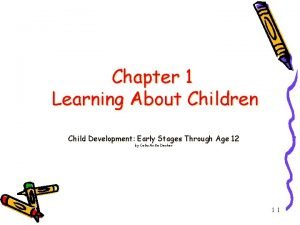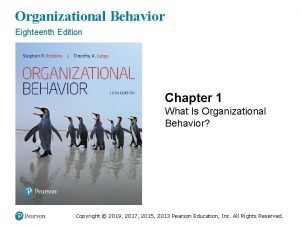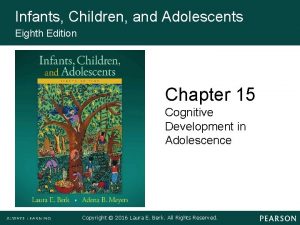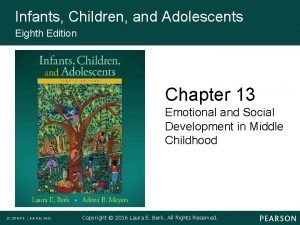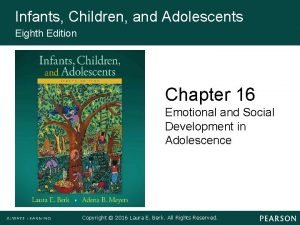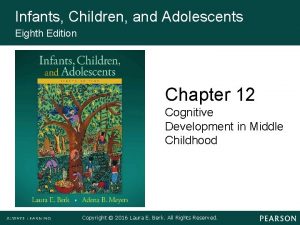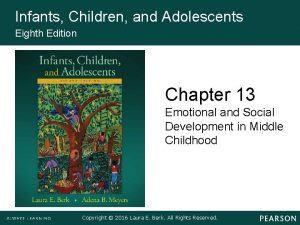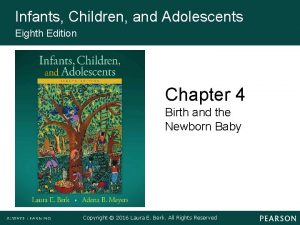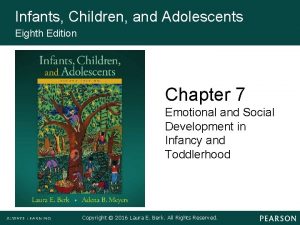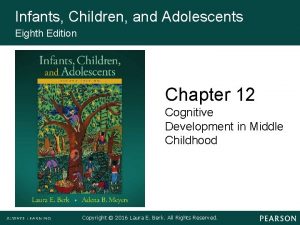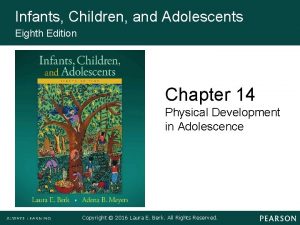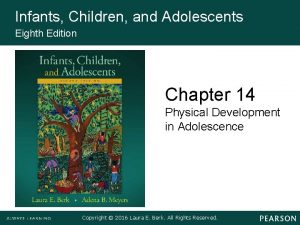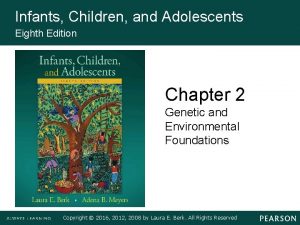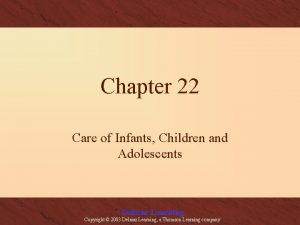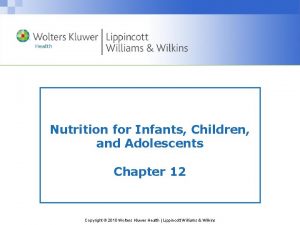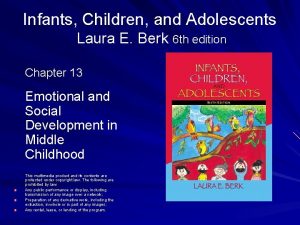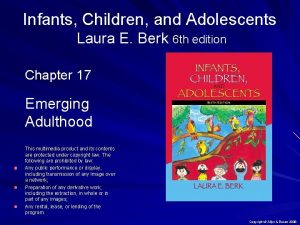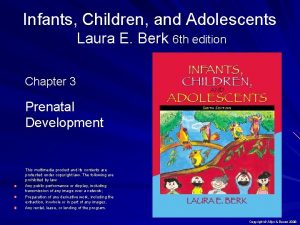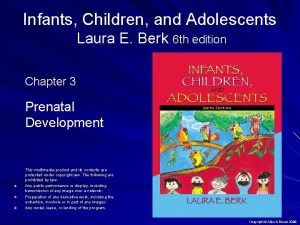Infants Children and Adolescents Eighth Edition Chapter 9



















































- Slides: 51

Infants, Children, and Adolescents Eighth Edition Chapter 9 Cognitive Development in Early Childhood Copyright © 2016 Laura E. Berk. All Rights Reserved.

Learning Objectives (1 of 3) Cognitive Development • • 1. Describe advances in mental representation, and limitations of thinking, during the preoperational stage. 2. What does follow-up research imply about the accuracy of Piaget’s preoperational stage? 3. What educational principles can be derived from Piaget’s theory? 4. Describe the social origins and significance of children’s private speech. Copyright © 2016 Laura E. Berk. All Rights Reserved.

Learning Objectives (2 of 3) Learning • • 5. How do attention, memory, and problem solving change during early childhood? 6. Describe the young child’s theory of mind. 7. Summarize children’s literacy and mathematical knowledge during early childhood. 8. Describe the content of early childhood intelligence tests and the impact of home, preschool and kindergarten programs, child care, and educational media on mental development. Copyright © 2016 Laura E. Berk. All Rights Reserved.

Learning Objectives (3 of 3) Skills • • 9. 10 Trace the development of vocabulary, grammar, and conversational skills in early childhood. 9. 11 Cite factors that support language learning in early childhood. Copyright © 2016 Laura E. Berk. All Rights Reserved.

Piaget’s Preoperational Stage • Ages 2 to 7 • Sensorimotor activity leads to internal images of experience, which children then label with words. • Advances in mental representation: – Development of make-believe play – Gains in understanding of symbol–real-world relations Copyright © 2016 Laura E. Berk. All Rights Reserved.

Development of Make-Believe • With growing symbolic mastery, play – detaches from real-life conditions associated with it. – becomes less self-centered. – includes more complex combinations of schemes. • By the end of the second year, children engage in sociodramatic play with peers. Copyright © 2016 Laura E. Berk. All Rights Reserved.

Benefits of Make-Believe • Leads to gains in social competence. • Strengthens cognitive capacities: – Sustained attention – Inhibition of impulses – Memory – Logical reasoning – Language and literacy – Imagination, creativity, perspective taking • Imaginary companions enhance pretend play. Copyright © 2016 Laura E. Berk. All Rights Reserved.

Enhancing Make-Believe Play in Early Childhood • Provide sufficient space and play materials. • Encourage children’s play without controlling it. • Offer a variety of realistic materials as well as materials without clear functions. • Ensure that children have many rich, real-world experiences to inspire positive fantasy play. • Help children solve social conflicts constructively. Copyright © 2016 Laura E. Berk. All Rights Reserved.

Dual Representation • Viewing a symbolic object as both an object in its own right and a symbol • Mastered around age 3 • To support children’s dual representation, – point out similarities between models and realworld spaces. – expose young children to symbols (picture books, drawings, make-believe, maps). Copyright © 2016 Laura E. Berk. All Rights Reserved.

Limitations of Preoperational Thought • Egocentrism • Animistic thinking • Inability to conserve: – Centration – Irreversibility • Lack of hierarchical classification Copyright © 2016 Laura E. Berk. All Rights Reserved.

Egocentric and Animistic Thinking • Egocentrism: – Failure to distinguish others’ symbolic viewpoints from one’s own – Demonstrated by Piaget’s three-mountains problem • Animistic thinking: – Belief that inanimate objects have lifelike qualities – Magical thinking: assigning human purposes to physical events Copyright © 2016 Laura E. Berk. All Rights Reserved.

Some Piagetian Conservation Tasks Figure 9. 2 Copyright © 2016 Laura E. Berk. All Rights Reserved.

Piagetian Class Inclusion Problem • Lack of hierarchical classification also demonstrates preoperational children’s centration and irreversibility: Q: “Are there more red flowers or flowers? ” A: “Red flowers. ” • Children center on the overriding feature (red) and do not think reversibly, moving from the whole class (flowers) to its parts (red, blue). Copyright © 2016 Laura E. Berk. All Rights Reserved.

A Piagetian Class Inclusion Problem Figure 9. 3 Copyright © 2016 Laura E. Berk. All Rights Reserved.

Follow-Up Research on Preoperational Thought (1 of 2) • Egocentrism: – On simplified tasks with familiar objects, 3 -year-olds show clear awareness of others’ vantage points. – Perspective taking develops gradually throughout childhood and adolescence. • Animistic and magical beliefs: – Even infants have begun to distinguish animate from inanimate. – Preschoolers’ notions of magic are flexible and appropriate. Copyright © 2016 Laura E. Berk. All Rights Reserved.

Follow-Up Research on Preoperational Thought (2 of 2) • Logical thought: – On simplified, relevant tasks, preschoolers display logical thinking. – Preschoolers engage in impressive reasoning by analogy about physical changes. • Categorization: – Preschoolers flexibly organize knowledge into nested categories. – Children’s categories differentiate into basic-level categories and subcategories. Copyright © 2016 Laura E. Berk. All Rights Reserved.

Children’s Questions: Catalyst for Cognitive Development • Majority of children’s questions are informationseeking, not requests: • Answers to questions provide precise knowledge when children need it. • Content of questions is related to children’s cognitive development. • Questions are influenced by context. • Adults alter complexity of their answers based on children’s maturity. Copyright © 2016 Laura E. Berk. All Rights Reserved.

Piaget and Educational principles derived from Piaget: • Discovery learning: opportunities for spontaneous interaction with environment • Sensitivity to children’s readiness to learn: building on children’s current thinking • Acceptance of individual differences: activities for individual children and small groups Copyright © 2016 Laura E. Berk. All Rights Reserved.

Children’s Private Speech • Piaget called children’s self-directed utterances egocentric speech. • Vygotsky viewed self-directed speech as foundation for all higher cognitive processes. • Private speech – is used for self-guidance, especially when tasks are in zone of proximal development. – gradually changes into whispers and silent lip movements. – is used more and over a longer period by children with learning problems. Copyright © 2016 Laura E. Berk. All Rights Reserved.

Relationship of Private Speech to Task Difficulty Among 5 - and 6 -Year-Olds Figure 9. 4 (Adapted from Fernyhough & Fradley, 2005. ) Copyright © 2016 Laura E. Berk. All Rights Reserved.

Social Origins of Early Childhood Cognition • Intersubjectivity: process by which two participants arrive at shared understanding of a task • Scaffolding: adjusting support offered during a teaching session to fit child’s current level of performance • Guided participation: shared endeavors between more and less expert participants, varying across situations and cultures Copyright © 2016 Laura E. Berk. All Rights Reserved.

Vygotsky and Early Childhood Education • Vygotskian classrooms promote assisted discovery: – Teachers guide children’s learning with explanations, demonstrations, and verbal prompts. – Children with varying abilities engage in peer collaboration, working together in groups. • Challenges to Vygotsky’s theory: – Verbal dialogues are not the only means through which children learn. – Vygotsky says little about how basic motor, perception, attention, memory, and problem-solving skills contribute to higher cognitive processes. Copyright © 2016 Laura E. Berk. All Rights Reserved.

Children in Village and Tribal Cultures Observe and Participate in Adult Work • Western cultures: – School prepares children for adult work. – Parents focus on preparing children for school success. – Emphasis is on child-focused activities. • Village/tribal cultures: – – – Children receive little formal schooling. Learning comes from observing adults at work. Children assume adult responsibilities early. Children make more decisions for themselves. Make-believe play and scaffolding are limited. Copyright © 2016 Laura E. Berk. All Rights Reserved.

Information Processing: Attention • Sustained attention improves in toddlerhood and early childhood. • Children gain in ability to inhibit impulses and focus on a competing goal. • Gains in working memory permit more complex play and problem-solving goals. • Adult scaffolding of attention supports gains in language and executive function. Copyright © 2016 Laura E. Berk. All Rights Reserved.

Information Processing: Planning • In early childhood, children become better at planning. • Effective planning is mastered around age 5, with gains in inhibition and working memory. • Children learn from parental encouragement and cultural tools that support planning. Copyright © 2016 Laura E. Berk. All Rights Reserved.

Miniature Zoo Used to Assess Children’s Planning Figure 9. 6 (Based on Mc. Colgan & Mc. Cormack, 2008. ) Copyright © 2016 Laura E. Berk. All Rights Reserved.

Information Processing: Memory Recognition Easier for young children and adults Nearly perfected by age 4 or 5 Copyright © 2016 Laura E. Berk. All Rights Reserved. Recall Much poorer than recognition in young children Associated with language development Hindered by limited working memory, lack of skill at using memory strategies

Memory for Everyday Experiences • Episodic memory: memory of everyday experiences • Scripts: memory of familiar, repeated events – become more elaborate and spontaneous with age. – help children interpret and predict everyday experiences. – assist children in recall, make-believe play, and planning. Copyright © 2016 Laura E. Berk. All Rights Reserved.

Autobiographical Memory • Two styles of caregiver–child communication: Elaborative Style Follows child’s lead Asks varied questions Adds information Volunteers own recollections Repetitive Style Provides little information Keeps repeating same questions Ignores child’s interest • Elaborative style leads to better recall and more organized, detailed personal stories one to two years later. Copyright © 2016 Laura E. Berk. All Rights Reserved.

Problem Solving in Early Childhood According to overlapping-waves theory, children • try a variety of strategies to solve challenging problems. • observe which strategies work best, which work less well, and which are ineffective. • gradually select strategies on the basis of accuracy and speed. Copyright © 2016 Laura E. Berk. All Rights Reserved.

Overlapping-Waves Pattern of Strategy Use Figure 9. 7 (From R. S. Siegler, Emerging Minds: The Process of Change in Children’s Thinking. Copyright © 1996 by Oxford University Press, Inc. Adapted by permission of Oxford University Press, Inc. ) Copyright © 2016 Laura E. Berk. All Rights Reserved.

The Young Child’s Theory of Mind • Theory of mind, or metacognition: coherent set of ideas about mental activities • Milestones in awareness of mental life: • Age 1: Babies view people as intentional beings who can share and influence one another’s mental states. • Age 2: Children display clearer grasp of others’ emotions and desires. • Age 3: Children realize that thinking is internal, but focus only on desires, not beliefs. • Age 4: Children realize that both beliefs and desires determine behavior, and become aware of false beliefs. Copyright © 2016 Laura E. Berk. All Rights Reserved.

Example of a False-Belief Task Figure 9. 8 Copyright © 2016 Laura E. Berk. All Rights Reserved.

Factors Contributing to Preschoolers’ Theory of Mind • Language and verbal reasoning about mental states: Left prefrontal cortex plays a crucial role. • Executive function: Several aspects of executive function predict false-belief mastery. • Make-believe play: Make-believe offers a rich context for thinking about the mind. • Social interaction: Social experiences promote understanding of the mind. Copyright © 2016 Laura E. Berk. All Rights Reserved.

Autism and Theory of Mind • Autism is characterized by – limited ability to engage in nonverbal social behaviors. – delayed, stereotyped language. – much less make-believe play than other children. – narrow, intense interests. • Impaired theory of mind linked to autism may be due to several brain-based deficits. Copyright © 2016 Laura E. Berk. All Rights Reserved.

Early Literacy Development • Preschoolers’ understanding of written language begins before they learn to read or write. • Emergent literacy: children’s active efforts to construct literacy knowledge through informal experience: – Children gradually figure out the symbolic function of print. – Phonological awareness strongly predicts emergent literacy. • Informal literacy experiences contribute to earlier and better literacy. Copyright © 2016 Laura E. Berk. All Rights Reserved.

Supporting Emergent Literacy in Early Childhood • Provide literacy-rich home and preschool environments. • Engage in interactive book reading. • Provide outings to libraries, museums, parks, zoos, and other community settings. • Point out letter–sound correspondences, play language– sound games, read rhyming poems and stories. • Support children’s efforts at writing, especially narrative products. • Model literacy activities. Copyright © 2016 Laura E. Berk. All Rights Reserved.

Reading Readiness Skills at Kindergarten Entry by SES Figure 9. 10 (Adapted from Lee & Burkham, 2002. ) Copyright © 2016 Laura E. Berk. All Rights Reserved.

Early Childhood Mathematical Reasoning • Mathematical reasoning builds on informal knowledge. • Toddlers display beginning grasp of ordinality. • By age 3½ to 4, most children grasp cardinality. • An understanding of basic arithmetic makes estimation possible. Copyright © 2016 Laura E. Berk. All Rights Reserved.

Individual Differences in Mental Development Early childhood intelligence tests: – Verbal questions and nonverbal tasks – Effects of cultural bias Environmental factors: – – Home environment Quality of preschool or kindergarten (child-centered vs. academic) Value of high-quality early intervention for at-risk preschoolers – Exposure to educational and entertainment media Copyright © 2016 Laura E. Berk. All Rights Reserved.

Features of a High-Quality Home Life for Preschoolers: The HOME Early Childhood Subscales • Availability of toys, games, and reading material • Regular parent–child conversations • Clean, uncluttered rooms • Parental pride, affection, and warmth • Stimulation of academic behavior • Modeling and encouragement of social maturity • Opportunities for regular outings • Avoidance of physical punishment Copyright © 2016 Laura E. Berk. All Rights Reserved.

Types of Preschool and Kindergarten • Child-centered programs: Teachers provide activities from which children select; most of the day is devoted to play. • Academic programs: Teachers structure children’s learning through formal lessons, often using repetitive drills. • Montessori education: This child-centered approach places equal emphasis on academic and social development. Copyright © 2016 Laura E. Berk. All Rights Reserved.

Early Intervention for At-Risk Preschoolers • Project Head Start: – The program currently serves nearly 1 million U. S. families. – Parent involvement is central to its philosophy. • Benefits: – Higher IQ and achievement scores in the early school years – Less special education and grade retention – More high school graduation, college enrollment Copyright © 2016 Laura E. Berk. All Rights Reserved.

Child Care • Substandard child care can impair cognitive and social skills and psychological well-being. • Good child care enhances language, cognitive, and social development, especially for low-SES children. • Center-based care is more strongly linked to cognitive gains than home-based care. Copyright © 2016 Laura E. Berk. All Rights Reserved.

Signs of Developmentally Appropriate Early Childhood Programs • Safe, clean, richly equipped physical setting • No more than 18– 20 children with 2 teachers • No more than 8– 10 children with each teacher • Small-group and individual activities chosen by children • Positive adult–child interactions • Specialized, college-level teacher preparation • Encouragement of parent observation and participation • State licensing and voluntary accreditation (NAEYC, NAFCC) Copyright © 2016 Laura E. Berk. All Rights Reserved.

Educational Television • TV remains dominant form of youth media. • Time spent watching educational programs (such as Sesame Street) leads to – gains in early literacy and math skills. – academic progress in elementary and high school. • Background TV viewing – impairs sustained attention. – decreases quantity and quality of parent–child interaction. – delays acquisition of reading skills. Copyright © 2016 Laura E. Berk. All Rights Reserved.

Computer Learning • Computers can have rich educational benefits. • Computer-learning centers in early childhood classrooms encourage language, literacy, and arithmetic skills. • Simplified computer languages introduce programming skills and promote problem solving and metacognition. • Most of young children’s time on computers and other screen media is spend on entertainment, especially game playing. Copyright © 2016 Laura E. Berk. All Rights Reserved.

Vocabulary Development in Early Childhood • Fast-mapping: connecting new words with underlying concepts after only a brief encounter • Mutual exclusivity bias: assumption that words refer to entirely separate categories • Syntactic bootstrapping: discovering word meanings by observing how words are used in syntax Copyright © 2016 Laura E. Berk. All Rights Reserved.

Grammar Development in Early Childhood • Overregularization: applying rules to words that are exceptions • Semantic bootstrapping: relying on word meanings to figure out grammatical rules • Persisting controversy over the existence of a universal, built-in language-processing device Copyright © 2016 Laura E. Berk. All Rights Reserved.

Conversation • Around age 2, preschoolers begin to master pragmatics. • Presence of sibling helps children acquire pragmatics. • By age 4, children adapt language to social expectations. • From ages 4 to 8, telephone talk improves significantly. Copyright © 2016 Laura E. Berk. All Rights Reserved.

Supporting Language Learning in Early Childhood • Recasts: restructuring incorrect speech into correct form • Expansions: elaborating on children’s speech, increasing its complexity • Role of adults: – Listening attentively – Elaborating on what children say – Modeling correct usage – Stimulating children to talk further Copyright © 2016 Laura E. Berk. All Rights Reserved.
 Infants, children, and adolescents 8th edition
Infants, children, and adolescents 8th edition Infants, children, and adolescents 8th edition
Infants, children, and adolescents 8th edition Gains in perspective taking permit the transition to
Gains in perspective taking permit the transition to Infants and children 8th edition
Infants and children 8th edition Psychology eighth edition david g myers
Psychology eighth edition david g myers David g myers psychology 8th edition
David g myers psychology 8th edition Operations management eighth edition
Operations management eighth edition The fifth, sixth, seventh, and eighth amendments protect *
The fifth, sixth, seventh, and eighth amendments protect * Adolescents defenition
Adolescents defenition Intellectual development of infants chapter 9
Intellectual development of infants chapter 9 Chapter 7 physical development of infants
Chapter 7 physical development of infants Anagram of eighth
Anagram of eighth Matching planet rings
Matching planet rings Nearest eighth of an inch
Nearest eighth of an inch 8th commandment catholic
8th commandment catholic Katja mahal
Katja mahal Arterier og vener
Arterier og vener Eighth amendment excessive bail
Eighth amendment excessive bail Eighth letter of the alphabet
Eighth letter of the alphabet Criminal justice lesson
Criminal justice lesson What's the 5th amendment
What's the 5th amendment Exceptional children 10th edition
Exceptional children 10th edition Cynthia lightfoot
Cynthia lightfoot The development of children 7th edition
The development of children 7th edition Introduction of exceptional child
Introduction of exceptional child Exceptional children 10th edition
Exceptional children 10th edition Mis chapter 6
Mis chapter 6 Using mis 10th edition
Using mis 10th edition The creative curriculum for infants toddlers and twos
The creative curriculum for infants toddlers and twos Rsv nursing diagnosis
Rsv nursing diagnosis Infants age range
Infants age range Watson give me a dozen healthy
Watson give me a dozen healthy Sentinel injuries in infants are
Sentinel injuries in infants are Junior infants art ideas
Junior infants art ideas Personality development in infancy
Personality development in infancy Derotative righting reflex
Derotative righting reflex Length board for infants
Length board for infants Chrisomes infants
Chrisomes infants Teaching phonics to junior infants
Teaching phonics to junior infants Dinamiques per treballar els drets dels infants
Dinamiques per treballar els drets dels infants 5 year old tammy mistakenly believes
5 year old tammy mistakenly believes Working with young children chapter 1
Working with young children chapter 1 Chapter 1 learning about children
Chapter 1 learning about children Chapter 1 learning about children
Chapter 1 learning about children Organizational behavior 18th edition
Organizational behavior 18th edition Pericyclic
Pericyclic Mechanics of materials 7th edition solutions chapter 10
Mechanics of materials 7th edition solutions chapter 10 Mechanics of materials 9th edition solution chapter 7
Mechanics of materials 9th edition solution chapter 7 Mechanics of materials 7th edition solutions chapter 6
Mechanics of materials 7th edition solutions chapter 6 Chapter 5 mechanics of materials solutions
Chapter 5 mechanics of materials solutions Beer and johnson
Beer and johnson Everything's an argument chapter 1
Everything's an argument chapter 1

